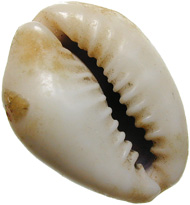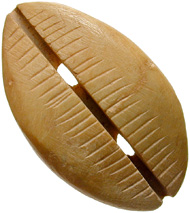The history of Chinese coinage 1 – from barter to monetary economy
Quite rightly, China prides itself of its long history, impressively evidenced by the Chinese monetary tradition that took a different route than our western one. Learn more about the development from barter trade to monetary economy here.
The cowry shells
Long before the coin was ‘invented’ in the west, at the turn of the 7th to the 6th century, China already used objects in the trade that served as a means for bartering. These, however, weren’t made of precious metal and didn’t have the classical coin shape. Since the 11th century B. C. at least, the shells of the cowry played a part in the economy as value standard, means of exchange and accumulation object.
The empty shell of a cowry belonging to the biological species of cypraea annulus. Cypraea annulus as well as cypraea moneta were used as currency. © MoneyMuseum, Zurich.
Originally, these cowries were nothing else than a sought-after trade item amongst many others, bartered in much the same way as corn, fabric, animals, jewelry or metal. But the cowry had one distinct advantage over the ones just named: it came in many identical specimens; it was durable and coveted in general since the cowry was considered a symbol and talisman for wealth.
Remains of an old cowry. © MoneyMuseum, Zurich.
As early as the 13th century, the cowry were considered a treasure and given away as a present. Only two centuries later it served a regular means of payment that was traded in ‘peng’, i.e. in the form of two strings with five cowries each.
The first prices that have come down to us date to this period. Yuan, Lord of Chu, had a ritual (hence very precious) bronze vessel manufactured for 10 and 4 ‘peng’ of cowries, i.e. 140 cowries. That cowry didn’t only serve as a means of payment but also as value standard is testified by another inscription. On a bronze from 923 B. C. we can read:
‘Citizen Ju Bai received from Qiu Wei one jade tablet worth 80 double strings of cowry for six fields of his lands: Ju as well got two pieces of red coral, a pair of knee pads made of goat skin and a luxuriant belly band worth 20 double strings of cowry for three fields of his lands.’
Cowry imitation made of bone. © MoneyMuseum, Zurich.
Cowries, therefore, were precious. They had to be transported from the coasts of the East Chinese Sea to the interior of the country and consequently were much too expensive to be used in a custom that the Chinese still retain. For providing the burials of the dead with votives, cowry imitations were the means of choice, carved from bone or nacre, or cast from bronze, silver and gold.
China. State of Chu, ant-nose coin, 4th/3rd cent. B. C. A number of these bronze items, also known as yibi, carry the inscription bei (= cowry) and served as substitute for the cowries that weren’t available in any quantity desired. © MoneyMuseum, Zurich.
At some point, the decisive step was taken: not just the cowries of the dead but also the cowries of the living were cast in bronze, most probably in the 8th century. By that, the economy had become independent of the cowry supplies for its money but was able to produce its own cowries. Hence, not the natural replenishment decided on the money circulating anymore but supply and demand: if more money was needed more bronze coins could be manufactured.
The spade coins
Not in all parts of China was the cowry THE object highly demanded. Its currency remained localized in the north of the country. In the central part of China, in the basin of the Yellow River, the people faced different conditions. They were peasants and had little use for a snail shell. Their daily routine revolved around the fields and their cultivation, and it is no surprise, then, that it was the spade which became the most important means of barter for them.
China. State of Zhou, spade coin, 4th cent. B. C. Our example for a spade coin belongs to the type with ‘square shoulders’, the most frequent one. The items measure between 9 and 10 centimeters and weigh roughly 30 grams. They were issued in the Warring States Period. © MoneyMuseum, Zurich.
At the beginning, around 1000 B. C., it most likely was real spades that served as value standard and objects of exchange. But the large items were rather bulky and so diminished forms began to be cast in the 8th cent. – roughly at the same time the bronze cowries were manufactured – which a peasant could no longer actually use but which were much more practical as currency. They were not only considerably smaller but, as a result, also lighter. Modern science divides them into many different groups. There are spades with a hollow handle, spades with square shoulders, spades with sloping shoulders, spades with pointed shoulders and pointed feet, thin square foot spades, arched foot spades and flat pointed foot spades. Thanks to archeological finds, all these shapes can be attributed to certain regions and eras.
The knife coins
While in the center of China money shaped like spades was circulating, another kind of money had been developed in the northern and north-eastern parts of the country.
China. State of Ch’i, knife coin, 4th cent. B. C. © MoneyMuseum, Zurich.
The vast lowlands there weren’t populated by peasants but by huntsmen and nomads. Their most important means of bartering of course wasn’t the spade but the knife used to eviscerate kill and to scrape the hides. In the north, therefore, a shrink form of the knife became money which found its way into Mongolia and Corea as well. Cowry shells, spades and knives circulated simultaneously until an entire new kind of money came into being most probably in the 3rd cent. B. C.
Read in the upcoming chapter how the Chinese cash came about.
Numerous examples of the history of Chinese coinage you will find informatively explained on the website of the MoneyMuseum.
Many of these objects in the MoneyMuseum are part of the Kuhn Collection.
You can read the next part here.
You can find all parts of this series here.




















